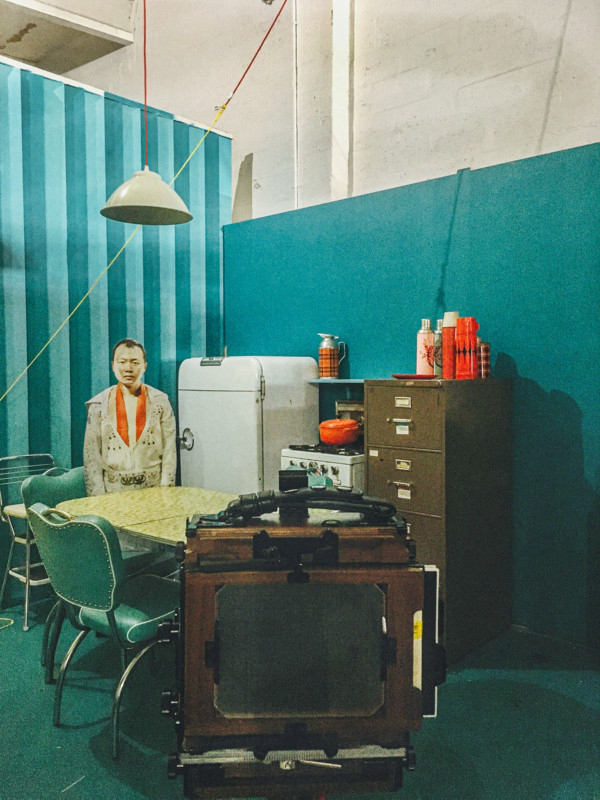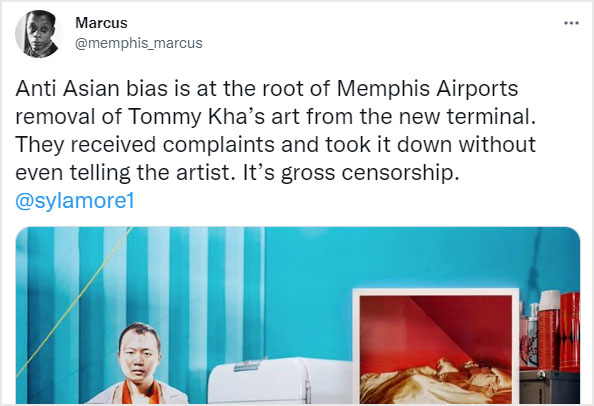Memphis Airport Reinstalls Photo of Asian Elvis Tribute Artist After Outcry
![]()
Memphis International Airport has issued an apology after abruptly removing and then reinstating photographer Tommy Kha’s self-portrait as an Elvis tribute artist.
When news of the removal sparked an uproar in the art community, however, the airport reinstated the photo and issued an apology to the artist.
An Artist Who Grew Up in Elvis’s Backyard
Photographer and artist Tommy Kha grew up in Whitehaven, just 2 miles from Elvis’s Graceland mansion situated on a 14-acre estate in Memphis, Tennessee.
After finishing a BFA in photography at the Memphis College of Art in 2013, he went on to be awarded an MFA in photography from the prestigious program at Yale University.
He is currently based in Brooklyn, New York, and Memphis, Tennessee, and his work has been displayed by international museums and galleries. He has been selected for residencies and has won many awards and fellowships.
Kha has had a long history with the iconography of Elvis and his tribute artists (sometimes referred to as impersonators).
A Self-Portrait as an Elvis Tribute Artist
Kha shot a self-portrait of himself as an Elvis tribute artist at Prop Planet, Miami, in 2017, and he titled the image Constellations VIII. It was captured on a Shen Hao 4×5 view camera with a Nikkor 135mm lens with ambient light and was intended to be a tribute to Elvis.

“Constellations is part of a group of pictures I made of my [life-sized] cardboard cutout,” Kha tells PetaPixel. “I think it is definitely a self-portrait though it is based on my performance persona, me as Andy Kaufman [considered to be one of the first notable Elvis tribute artists] as Elvis, minus the singing. The scene is entirely found but set up by my friend Carolina who runs Prop Planet.
“I made the photograph during my Fountainhead Residency in 2017. I tend to carry with me props or photographic limbs from parts of my body. I asked if I could set up my cardboard cutout and 4×5 view camera. I think I made two pictures, one with and one without the cutout.
“I was born and raised in Memphis. My work is informed by many things, and I think Elvis seeps in and out of my work in different ways.”
Kha’s “practice is based in play and possibilities.” He is interested in different ways photographs can be presented. So, they have been vinyl folded and occupying two corners of a gallery, a straight-forward framed print, a billboard in Los Angeles, a slideshow, a magnet, etc.
He does not Photoshop apart from color grading and cropping, which was also done in the analog darkroom. Everything is done in-camera and there is no compositing or double exposures.
How the Elvis Photo Landed at the Airport
UrbanArt Commission, an independent public art non-profit based in Memphis, launched Memphis International Airport’s Art Collection in 2021 with the renovation of the B concourse. $1.5 million was allocated to create new art projects at different locations throughout the terminal. A total of forty works of contemporary art and five site-specific installations were selected and Kha’s Constellations VIII, a digital print on vinyl, was one of them.
![]()
Emerging and established artists based in Memphis or connected to the city were included in the art collection of MEM.
These artists represent an ever-evolving arts community that meaningfully contributes to the rich cultural fabric of this city. Whether viewers are enjoying the details of a photograph or taking in an expansive mural, the collection offers an introduction to the many sides of Memphis; for those who call the city home… Inherent in the selected works is a sense of Memphis’s rich history as a place rooted in activism and civil rights, art, and music, and the continuation of that sacred legacy today. – UrbanArt Commission
“Like many of the artists, it was a year-long process,” explains Kha. “They purchased this specific selection in or around June 2021. I was invited to apply.”
After the commission rejected his initial submission, a selection of photos showing himself being kissed by strangers, he proposed the Elvis photo as his second submission and it was selected.
The Artwork is Suddenly Gone
Once the photo was installed in the airport, however, it began attracting criticism.
“[The Airport Authority] informed that they may temporarily remove the work,” Kha says. “But they would let me know before they did so.”
On March 10th, though, the artwork was abruptly removed without Kha begin informed ahead of time.
“That weekend, a few friends who knew about the situation went to the Airport and could not find my work,” explains Kha. “I didn’t get a confirmation until I asked the Airport directly on March 16 that they confirmed they did indeed remove the work.”
The president of the airport authority, Scott Brockman, then released a statement:
“Recently, the Airport Authority has received a lot of negative feedback from Elvis fans about one of the art pieces that was purchased and installed in our recently modernized concourse,” Brockman said. “When the airport created its art program, our goal was to purchase and display artwork that did not include public figures or celebrities.
“Our selection committee made an exception in the case of Tommy Kha’s piece and recommended its purchase. This was the only piece in the art collection that depicted a celebrity or public figure. While we understand that the artist created the piece as a tribute to Elvis, the public reaction has been strong, leading us to revisit that original goal of avoiding the depiction of public figures in our art collection. As a result, the airport determined it was best to temporarily remove the piece while we determine our best path forward.
“We are open to the possibility of commissioning new artwork by Tommy Kha to replace his previous piece.”
“Among the complaints, there were a small number of comments that included language that referred to Mr. Kha’s race, and such comments are completely unacceptable. The Airport Authority does not support those comments, nor does it form the basis for the Authority’s decision regarding the piece. MSCAA has been very intentional to emphasize local artists, diversity, and inclusion with this art program, and we will continue to do so.”
Kha then responded to the removal himself on March 21st through his Twitter account.
![]()
“Apologies to those who wished to see this piece: it is no longer on display,” he wrote. “After some disturbing complaints about my work, it was decided, and without my knowledge, the pictures were removed. I’m the only artist they have removed.
“I’m quite disappointed as it was one of many artworks selected to hang in the new concourse–an honor that connected me to the place where I grew up (having grown up in Whitehaven, minutes away from Graceland), and the opportunity gave me hope that artists like myself could be represented. While I believe people are free to speak their minds, I do not agree that the removal was the right solution.
“For many years, I have created work that explores my own experiences of becoming an artist in the South. I love Memphis still and I love the countless contributions from many voices and people that have Memphis what it is to me: home.”
When word of the removal began to spread, voices in support of Kha and the artwork emerged and began to grow louder.
“We are opposed to Tommy Kha’s installation being removed from display, especially considering the openly racist comments made online in the development of this situation,” said the UrbanArt Commission in a statement. “Airport leadership has chosen to remove an artwork from a Memphis artist for reasons that we adamantly disagree with. UAC is in contact with the Memphis-Shelby County Airport Authority and advocates for the artwork to be reinstalled.”

The Reinstall and Apology
Within a week, Airport Authority walked back its decision to take the artwork down due to the outcry that ensued. It reinstalled the photo and issued an apology to Kha.
“Over the past 24 hours, we have heard from many in our community regarding the temporary removal of Tommy Kha’s artwork in the new concourse,” Brockman said in a statement on March 22. “The Airport Authority appreciates the support that the community has shown for Tommy and we have made the decision to reinstall the artwork.
“We apologize to Tommy for the effect that this ordeal has had on him.
“As stated yesterday, when the airport created its art program, our goal was to purchase and display artwork that did not include public figures or celebrities but made an exception in this case. The Airport Authority will continue to emphasize local artists, diversity, and inclusion with this art program, and we will explore additional best practices to address how we handle complaints and public feedback about our artwork.”
Kha says that he simply watched from the sidelines as people rallied behind him in this controversy.
“I was never involved in these negotiations [to reinstall], apart from their press release [in which president Brockman of the Airport Authority apologized to the artist] and a phone call on March 22 that they will reinstall it,” he says. “The next evening, it was back up.
“I definitely think it is because of community. My friends, family, other artists, friends and strangers, and neighbors all came together and shared my story and defended me and saw these comments to be quite hateful. They did what Memphis does best, and they showed what a sense of community and inclusion, things the art collection was trying to do. Instead, the removal of my work did quite the opposite.”
Kha says he is not dwelling on what happened but is instead looking forward.
“I rather talk about the other artists in the Collection or the work of Steve Yee, who was a Memphis-based Chinese American artist who just passed, and the many people,” Kha says. “I think there’re other more important things, and I like to focus on making sure this does not happen to other artists.”
Update on 4/11/22: Tommy Kha has informed us that the currently preferred term is “Elvis Tribute Artist” and not “impersonator”. We have edited this article with the updated language.
About the author: Phil Mistry is a photographer and teacher based in Atlanta, GA. He started one of the first digital camera classes in New York City at The International Center of Photography in the 90s. He was the director and teacher for Sony/Popular Photography magazine’s Digital Days Workshops. You can reach him here.
Image credits: Header photo by Tommy Kha. All other photos provided by Tommy Kha.